
An ecosystem is a system that environments and their organisms form through their interaction. The biotic and abiotic components are linked together through nutrient cycles and energy flows.

A forest is an ecosystem characterized by a dense community of trees. Hundreds of definitions of forest are used throughout the world, incorporating factors such as tree density, tree height, land use, legal standing, and ecological function. The United Nations' Food and Agriculture Organization (FAO) defines a forest as, "Land spanning more than 0.5 hectares with trees higher than 5 meters and a canopy cover of more than 10 percent, or trees able to reach these thresholds in situ. It does not include land that is predominantly under agricultural or urban use." Using this definition, Global Forest Resources Assessment 2020 found that forests covered 4.06 billion hectares, or approximately 31 percent of the world's land area in 2020.
This glossary of ecology is a list of definitions of terms and concepts in ecology and related fields. For more specific definitions from other glossaries related to ecology, see Glossary of biology, Glossary of evolutionary biology, and Glossary of environmental science.

Tropical rainforests are dense and warm rainforests with high rainfall typically found between 10° north and south of the Equator. They are a subset of the tropical forest biome that occurs roughly within the 28° latitudes. Tropical rainforests are a type of tropical moist broadleaf forest, that includes the more extensive seasonal tropical forests. True rainforests usually occur in tropical rainforest climates where no dry season occurs; all months have an average precipitation of at least 60 mm (2.4 in). Seasonal tropical forests with tropical monsoon or savanna climates are sometimes included in the broader definition.

An old-growth forest is a forest that has developed over a long period of time without disturbance. Due to this, old-growth forests exhibit unique ecological features. The Food and Agriculture Organization of the United Nations defines primary forests as naturally regenerated forests of native tree species where there are no clearly visible indications of human activity and the ecological processes are not significantly disturbed. One-third of the world's forests are primary forests. Old-growth features include diverse tree-related structures that provide diverse wildlife habitats that increases the biodiversity of the forested ecosystem. Virgin or first-growth forests are old-growth forests that have never been logged. The concept of diverse tree structure includes multi-layered canopies and canopy gaps, greatly varying tree heights and diameters, and diverse tree species and classes and sizes of woody debris.
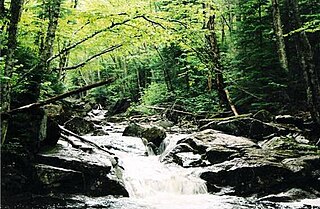
Ecosystem ecology is the integrated study of living (biotic) and non-living (abiotic) components of ecosystems and their interactions within an ecosystem framework. This science examines how ecosystems work and relates this to their components such as chemicals, bedrock, soil, plants, and animals.
An aquatic ecosystem is an ecosystem found in and around a body of water, in contrast to land-based terrestrial ecosystems. Aquatic ecosystems contain communities of organisms—aquatic life—that are dependent on each other and on their environment. The two main types of aquatic ecosystems are marine ecosystems and freshwater ecosystems. Freshwater ecosystems may be lentic ; lotic ; and wetlands.

In ecology, a disturbance is a temporary change in environmental conditions that causes a pronounced change in an ecosystem. Disturbances often act quickly and with great effect, to alter the physical structure or arrangement of biotic and abiotic elements. A disturbance can also occur over a long period of time and can impact the biodiversity within an ecosystem.
Ecological facilitation or probiosis describes species interactions that benefit at least one of the participants and cause harm to neither. Facilitations can be categorized as mutualisms, in which both species benefit, or commensalisms, in which one species benefits and the other is unaffected. This article addresses both the mechanisms of facilitation and the increasing information available concerning the impacts of facilitation on community ecology.
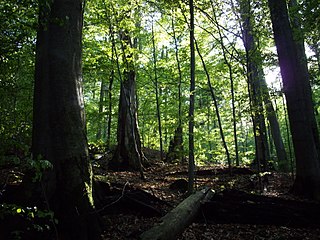
Temperate deciduous or temperate broad-leaf forests are a variety of temperate forest 'dominated' by deciduous trees that lose their leaves each winter. They represent one of Earth's major biomes, making up 9.69% of global land area. These forests are found in areas with distinct seasonal variation that cycle through warm, moist summers, cold winters, and moderate fall and spring seasons. They are most commonly found in the Northern Hemisphere, with particularly large regions in eastern North America, East Asia, and a large portion of Europe, though smaller regions of temperate deciduous forests are also located in South America. Examples of trees typically growing in the Northern Hemisphere's deciduous forests include oak, maple, basswood, beech and elm, while in the Southern Hemisphere, trees of the genus Nothofagus dominate this type of forest. Temperate deciduous forests provide several unique ecosystem services, including habitats for diverse wildlife, and they face a set of natural and human-induced disturbances that regularly alter their structure.

Plant ecology is a subdiscipline of ecology that studies the distribution and abundance of plants, the effects of environmental factors upon the abundance of plants, and the interactions among plants and between plants and other organisms. Examples of these are the distribution of temperate deciduous forests in North America, the effects of drought or flooding upon plant survival, and competition among desert plants for water, or effects of herds of grazing animals upon the composition of grasslands.

Mycoforestry is an ecological forest management system implemented to enhance forest ecosystems and plant communities, by introducing the mycorrhizal and saprotrophic fungi. Mycoforestry is considered a type of permaculture and can be implemented as a beneficial component of an agroforestry system. It can enhance the yields of tree crops and produce edible mushrooms, an economically valuable product. By integrating plant-fungal associations into a forestry management system, native forests can be preserved, wood waste can be recycled back into the ecosystem, carbon sequestration can be increased, planted restoration sites are enhanced, and the sustainability of forest ecosystems are improved. Mycoforestry is an alternative to the practice of clearcutting, which removes dead wood from forests, thereby diminishing nutrient availability and reducing soil depth.
Forest pathology is the research of both biotic and abiotic maladies affecting the health of a forest ecosystem, primarily fungal pathogens and their insect vectors. It is a subfield of forestry and plant pathology.
Monodominance is an ecological condition in which more than 60% of the tree canopy comprises a single species of tree. Monodominant forests are quite common under conditions of extra-tropical climate types. Although monodominance is studied across different regions, most research focuses on the many prominent species in tropical forests. Connel and Lowman, originally called it single-dominance. Conventional explanations of biodiversity in tropical forests in the decades prior to Connel and Lowman's work either ignored monodominance entirely or predicted that it would not exist.
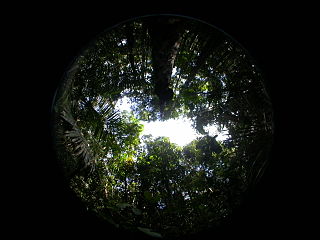
Gap dynamics refers to the pattern of plant growth that occurs following the creation of a forest gap, a local area of natural disturbance that results in an opening in the canopy of a forest. Gap dynamics are a typical characteristic of both temperate and tropical forests and have a wide variety of causes and effects on forest life.
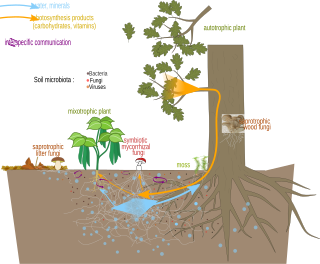
A mycorrhizal network is an underground network found in forests and other plant communities, created by the hyphae of mycorrhizal fungi joining with plant roots. This network connects individual plants together. Mycorrhizal relationships are most commonly mutualistic, with both partners benefiting, but can be commensal or parasitic, and a single partnership may change between any of the three types of symbiosis at different times.
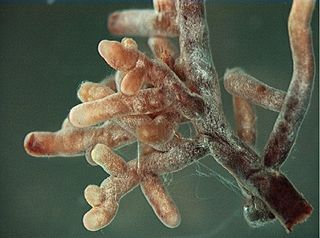
An ectomycorrhiza is a form of symbiotic relationship that occurs between a fungal symbiont, or mycobiont, and the roots of various plant species. The mycobiont is often from the phyla Basidiomycota and Ascomycota, and more rarely from the Zygomycota. Ectomycorrhizas form on the roots of around 2% of plant species, usually woody plants, including species from the birch, dipterocarp, myrtle, beech, willow, pine and rose families. Research on ectomycorrhizas is increasingly important in areas such as ecosystem management and restoration, forestry and agriculture.

The Japanese temperate rainforest is well sustained and maintains a high biodiversity. One method that has been utilized in maintaining the health of forests in Japan has been afforestation. The Japanese government and private businesses have set up multiple projects to plant native tree species in open areas scattered throughout the country. This practice has resulted in shifts in forest structure and a healthy temperate rainforest that maintains a high biodiversity.

In ecology, a light gap is a break in forest canopy or similar barrier that allows young plants to grow where they would be otherwise inhibited by the lack of light reaching the seedbed. Light gaps form predominantly when a tree falls, and thus produces an opening in the forest canopy. Light gaps are important for maintaining diversity in species-rich ecosystems.

The Tropical Wet Forests are a Level I ecoregion of North America designated by the Commission for Environmental Cooperation (CEC) in its North American Environmental Atlas. As the CEC consists only of Mexico, the United States, and Canada, the defined ecoregion does not extend outside these countries to Central America nor the Caribbean.




















